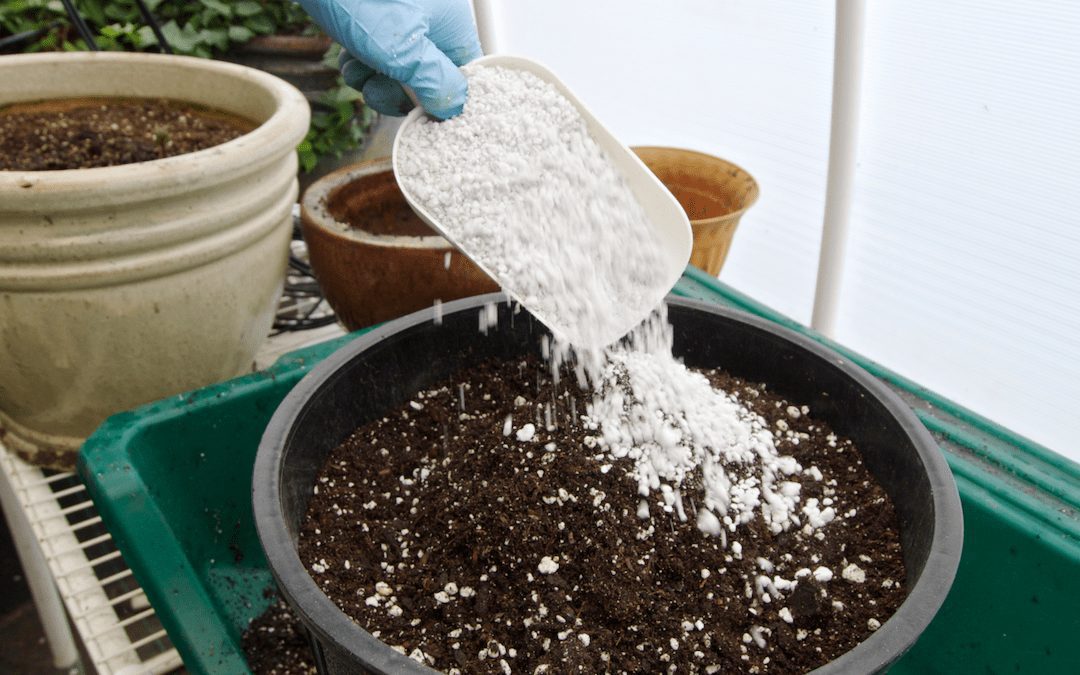Maybe you’ve heard us talk about adding perlite to your soil mixes, or perhaps you’ve seen it listed as an ingredient on the label of your potting soil; but do you know what it really is and what it does? Perlite is a soil amendment that can aid in the health and development of your plants and today we’ll explain just how it does that.
What is perlite? What does it do?
Perlite is a naturally occurring mineral, known as volcanic glass. In the horticultural world that mineral has been transformed by being crushed and then cooked in industrial ovens at an extremely high-heat which expands it, and the results are those little white balls that resemble tiny balls of styrofoam. There is a much more scientific way to explain the process, but this is horticultural version in a nutshell.
These little white balls are very porous and structurally stable. They do not lose their shape even when pressed into soil. They create pockets of air in the soil which help to improve aeration, increasing oxygen throughout the soil, which leads to strong and healthy root development in plants.

Drainage is also greatly improved in soil which is a must for plant vitality. While plants definitely need water to live, excess water can be the kiss of death to the roots of plants if they sit in too much moisture for too long. Perlite is an excellent medium for filtering out excess water, leaving your roots with plenty of access to life-sustaining oxygen. This is one of the many reasons we encourage gardeners to mix in plenty of this amazing soil amendment into your potting soils, especially when you are potting up plants that really won’t tolerate wet soils at all (like succulents and cacti).
The addition of perlite also helps to lighten the weight of soil. Over time, heavy soils can get compacted. Compacted soil inhibits root development. When roots try to grow through compacted soil, it is basically like hitting a brick wall. Since perlite retains its structure and does not get compacted, it keeps soil mixes light and airy, keeping those pockets of air intact, and providing plenty of space for tender, young roots of plants to easily make their way through to develop and grow.

5 Ways to Use Perlite:
1. To propagate stem cuttings (stimulates root growth, drains away excess moisture). Depending on what plants you are attempting to propagate, try these ratios:
- 2 parts peat moss, 1 part perlite, or
- 1 part perlite, 1 part coco coir, or
- 2 parts peat moss, 1 part perlite, 1 part vermiculite (see note below on vermiculite)
2. Seed starting mix: 1 part perlite, 1 part coco coir, 1 part vermiculite
3. Create a perfect standard potting mix using: 1 part perlite, 1 part peat moss, and 1 part sandy loam
4. Perfect succulent mix: 1 part perlite, 1 part fine charcoal, 4 parts horticultural sand
5. Use perlite as a hydroponic growing medium.
A quick side note, because vermiculite is sometimes confused with perlite. Vermiculite does many of the same jobs, such as increased soil aeration, and reduced soil compaction, but vermiculite has more water retention properties than perlite. Vermiculite would be a better choice for tropical types of plants, and plants that tend to thrive on more humidity and soil moisture.
As you can see, perlite is a dynamite way to ramp up your soil mixes, by increasing drainage, aeration, retaining nutrients, and providing a light, fluffy, environment for roots to easily grow through and develop into strong, healthy plants. Ready to give it a try? Bags of this goodness await you at Rainbow Gardens!
~The Happy Gardener, Lisa Mulroy


What about spreading it (perlite, mixed with peat moss) after having the lawn mechanically aerated; then having compost spread on top?
Sure! You can use perlite for that too! Here’s an article that has a visual for how it helps. Perlite for Gardens and Lawns.
Hey! Very informative article. Thanx!
Hi Tim,
Thanks so much for reading and taking the time to respond! Truly appreciate that!
Is Perlite good with geraniums, petunias, cyclamen, and other bedding plants ?
Hi Cindy,
Absolutely! Perlite is great for all of those bedding and container plants. It has a neutral pH so it can be included in all your plantings.
I recently relocated from Washington and would like to start growing Asian vegetables. Do you have a book that can guide me to do this? Or can you give me advice. Thank you
Hi Lorraine,
Love that you have an interest in Asian vegetables! We do not have a book to recommend at this point, but when in season, we do tend to carry some Asian Greens, Ichiban eggplant, Chinese long beans, many Asian varietals of peppers, and more… and we try to provide growing information on our signage at the nurseries. We have many guides on getting started on vegetable gardening that are sure to help in general. You can find these through searching the keyword vegetables on our site, and we are getting ready to roll out our new Learning Center on the site in March, which will have all of our guides, articles, and other helpful links in one easy spot. Hope this helps you some!